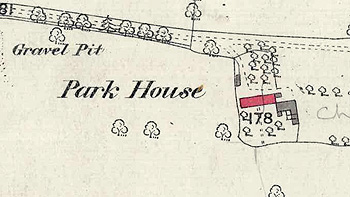Little Park House Bromham

Park House on a map of 1884
Little Park House used to be called Park House. It lies in a great eastern ox-bow bend of the River Great Ouse roughly equidistant from the villages of Bromham and Clapham. The farmhouse was listed by English Heritage in August 1987 as Grade II, of special interest. It dates from the 17th century though it has modern extensions. It is constructed from coursed limestone rubble and has a thatched roof. The more modern part stands at right angles to the main body of the house. The house comprises two storeys and a thatched stone barn with a dormer window abuts it to the east.
The building belonged, by 1855 at least, to Bromham church. A terrier of church property of 1855 [P67/2/6] describes a “a dwelling house 48 feet long, 20 feet wide built partly with stone, timber, plaster and boards consisting of a parlour with a boarded Floor, a Kitchen, Scullery, pantry and Cellar bricked with three Rooms over boarded, an outbuilding adjoining 26 feet long, 18 feet wide built partly with stone, timber, plaster and boards containing a Dairy with a bricked Floor, a Room over boarded and a Barn. The House with the Garden, yard and outbuildings 1 rood 16 perches & half. A small close adjoining 1 acre, 1 rood, 16 perches, a close called Lucas’ Close with the Lane leading to Clapham from Bromham containing 10 acres, 3 roods, 39 perches (Road included). The whole abutting South on the Park formerly called Oat Close, North and West on Cabin Ground, East upon Clay Pit Close”.
The Rating and Valuation Act 1925 specified that every building and piece of land in the country was to be assessed to determine its rateable value. The valuer visiting the property in 1927 [DV1/H8/60] found it was still owned by the churchwardens of Bromham and rented by W. R. King for £31 per annum (the rent had been £21 per annum until 1921).
The building was farmhouse to a smallholding of 12 acres, 2 roods. The valuer commented: “A little holding really in the middle of Park Farm. Has a hard road down to it though. Some way from main road. One very useful grass field”. At the time of the assessment, 1927, the house was vacant but comprised a kitchen, a parlour, a scullery, a pantry and three bedrooms. Water came from a pump. The reason it was empty was, presumably, because it was, in the valuer’s words: “very, very old and Bad”.
Outside stood a wood and tiled store (“was dairy”), three old open hovels, a wood and thatched chaff house, a wood and tiled nag stable, a cow shed for ten beasts and two calf boxes and a wood and corrugated iron two bay open hovel. Once more the valuer was damning: “Very old poor place in very bad repair”.
The church sold the property and the smallholding in 1928. The parochial church council minute for 23rd November that year [P67/32/2] reads: “Mr. Peacock reported on the sale of Little Park Farm which had been recently brought to a very satisfactory conclusion. The property had realized the sum of £1,000; expenses amounted to £32.15.6, thus leaving a net result of £967.4.6. This amount has been invested in the name of “The Official Trustees of Charitable Funds” in £942.7.7. 5% War Stock 1929-1947 by the Charity Commissioners. The dividends were ordered to be paid into the Bromham Parochial Church Council’s Account with the Bedford Branch of the Westminster Bank Limited. Mr. Brierley [of Woodstock Cottage] through whose hands much of the business passed was heartily thanked for his help in the matter”.
On 14th September 1940 a fifty kilogramme bomb was dropped one hundred yards north-west of Little Park House, as it has been renamed. Luckily, this bomb failed to explode and was only discovered on 3rd May 1941 [WW2/AR/CO/2/3].
A file of correspondence about the tenancy of the house survives in the archive of estate agents McConnells [Z938/10/2/17]. Little Park House, Bromham. By 1945 the owner of the property was Mrs. H. Wells of Ickwell and the tenant, whose lease was due to expire the following year, was Miss Eugster. A wing Commander Bowler expressed an interest in taking over the tenancy but in the event was moved to RAF Brampton near Huntingdon and so did not do so. In the event the new tenant was Lieutenant-Colonel M. F. T. Baines. His tenancy did not begin happily: the bathroom ceiling collapsed in 1947 and severe storm damage occurred the following month.
![Little Park House in 1956 [X535/3]](/CommunityHistories/Bromham/Bromhamimages/Little Park House in 1956 [X535-3].jpg)
Little Park House in 1956 [X535/3]